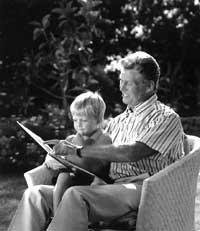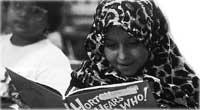Dyslexia can be corrected
1997/05/01 Agirre, Jabier - Medikua eta OEEko kidea Iturria: Elhuyar aldizkaria
Dyslexia is currently defined as a barrier that affects the learning process of reading and writing, without detecting in the child any emotional, sensory (visual or auditory) or intellectual deficiency. Some theories argue that it would be related to spatial orientation errors or visual coordination alterations. According to specialists, the prevalence of this disease in the general population is 6%, and in the child population, specifically, one in 10 people would be affected by the disease (the number of children is usually double that of girls).
Why does dyslexia arise?

Several theories have been mentioned to explain the origin of dyslexia. Some of them believe that a structural difference would emerge in the child's brain that would affect language. On the other hand, there are studies that report a higher prevalence of dyslexia among relatives of the same family and that therefore the disease can have a genetic basis.
How to know if a child has dyslexia or not?
Dyslexia cannot be diagnosed clearly until the child is six to seven years old (and always with a psychologist, speech therapist or expert). However, the imbalance between the child's intellectual ability and written language skills is already evident, as it is enough for both parents and teachers to test themselves. These children cannot correctly learn the letters (alphabet), they are not able to analyze the components of the words, which entails a slow reading, painful and full of errors (eat the letters or have a similar spelling, for example b and d, confuse, have difficulty pronouncing, get stuck with punctuation signs, when the words are quite long or difficult the reading is totally wrong, etc. ).
Of course, dyslexia can be of a different level, and not all dyslexic children have the same delay or difficulty in school, but it is usually difficult for most to perform tasks or tasks that require more than one skill. For example, and when children are more interpenetrated, if asked to write, it will cost the dyslexic to simultaneously control spelling, punctuation and the organization of ideas. They need more time to do any written work and always go against the clock to finish things with their peers. This can cause frustration in the child and therefore it is so important that in the subsequent treatment there is a close relationship between the child care specialist, ikastola teachers and parents.
Is dyslexic a peak?
Not much less. Dyslexic children are as smart as any other child, but they understand things differently. Their neurological structure is different, but if they offer a strategy and a special help to face their learning process without fear, they are able to compensate, recover and solve many problems. Dyslexia is not a disease in the strict sense of the word, although earlier I have written the opposite, but a different way of learning. And accepting these difficulties or differences often depends on the attitude of the parents. At first the parents are as lost as the child, but you have to be patient, try to understand it and never ask the child more than he can get with his maximum level of effort.
Importance of diagnosis

The most basic tool is early detection to achieve a good level of recovery and avoid school failure. Logotherapists know perfectly well that there are no two dyslexic children alike. Therefore, and once the diagnosis of dyslexia is fixed, a personalized treatment is recommended, which should be carried out the week before the age of nine, since over time also the habits and customs of the child are consolidated and the correction of difficulties is much more difficult.
Dyslexia will never be completely cured, there it is inside, as in lethargy, but today with proper treatment can be greatly improved and corrected. We cannot speak of a universal pattern because each case has its own nuances, but we almost always use motor coordination exercises and motor skills, separation exercises of letters with similar shapes and sounds, exercises and games to solve problems of laterality or differentiate concepts like left/right or up/down.
As recent studies confirm, two out of three dyslexic children tend to have character and behavior disorders. Mª Victoria Carretero Díaz, a psychopedagogue specialist in children’s language, believes that “many of these children are rebellious, insecure, shy or shy. They have no self-confidence and are frustrated. Therefore, the attitude of the family is very important. If those closest to them do not help them, they will also question their possibilities and possibilities and the levels of security and self-esteem, which were already quite weak, will remain lower.
Duties for parentsSome simple tips for dealing with dyslexia at home:
|

Gai honi buruzko eduki gehiago
Elhuyarrek garatutako teknologia




